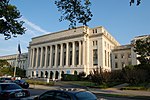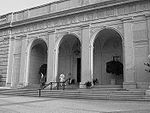United States Department of Agriculture Building
AC with 0 elementsBuildings and structures demolished in 1930Buildings of the United States government in Washington, D.C.Demolished buildings and structures in Washington, D.C.Government buildings completed in 1868 ... and 2 more
National MallUnited States Department of Agriculture facilities

The Department of Agriculture Building was the original headquarters of the United States Department of Agriculture located on the National Mall between 12th and 14th Street SW in Washington, D.C. after its creation in 1862. It was first occupied in 1868. However, it was not compatible with the McMillan Plan and was subsequently demolished in 1930.
Excerpt from the Wikipedia article United States Department of Agriculture Building (License: CC BY-SA 3.0, Authors, Images).United States Department of Agriculture Building
Independence Avenue Southwest, Washington
Geographical coordinates (GPS) Address Phone number Website Nearby Places Show on map
Geographical coordinates (GPS)
| Latitude | Longitude |
|---|---|
| N 38.888333333333 ° | E -77.029722222222 ° |
Address
United States Department of Agriculture
Independence Avenue Southwest 1400
20250 Washington
District of Columbia, United States
Open on Google Maps










